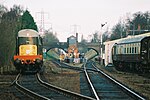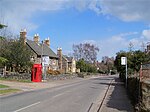Swithland railway station
Pages with no open date in Infobox stationUnbuilt railway stations in the United Kingdom
Swithland was a railway station which was constructed on the Great Central Main Line between Rothley and Quorn and Woodhouse. The station was due to open in March 1899 but was never completed although the line opened as planned in March 1899. The line through the station site was closed in May 1969. The line through the station was reopened in 1990 as the Great Central Railway.
Excerpt from the Wikipedia article Swithland railway station (License: CC BY-SA 3.0, Authors).Swithland railway station
The Ridings, Charnwood Swithland
Geographical coordinates (GPS) Address Nearby Places Show on map
Geographical coordinates (GPS)
| Latitude | Longitude |
|---|---|
| N 52.7143 ° | E -1.1677 ° |
Address
The Ridings
The Ridings
LE7 7SH Charnwood, Swithland
England, United Kingdom
Open on Google Maps










